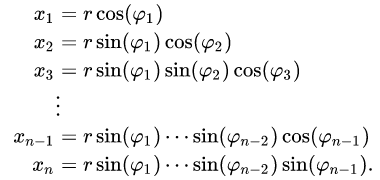Hi Denver!
First a brief word on mathematical terminology: A n-sphere is
described by n (independent) parameters and is often thought
of as being embedded in (n+1)-space.
So a 2-sphere is the (two-dimensional) surface of a three-dimensional
ball (embedded in 3-space). A 1-sphere is just the ordinary circle.
You most likely don’t want to implement these equations because
there are many locations where they are singular. (Also, the different
parameters are rather different in character.)
For most purposes you are much better off using n+1 slightly
redundant parameters to describe an n-sphere, namely the n+1
coordinates of a point in (n+1)-space that is constrained to be a
distance of 1 away from the origin. (This constraint describes /
eliminates the redundancy.)
Using softmax here is likely to be sub-optimal, because, among
other reasons, the “geometry” of softmax doesn’t really match well
with the geometry of a sphere.
If you want the output of your model to be an n-sphere, you should
have your model output n+1 unbounded real values (e.g., the
n+1 outputs of a final Linear layer), and then normalize that
(n+1)-dimensional vector to have unit norm. (That extra degree of
freedom that is normalized away isn’t really a problem. Networks,
in general, contain lots of redundancy.)
I suggest directly normalizing your (n+1)-dimensional output vector,
rather than passing it through softmax, but the general concept is
fully analogous.
As you say, because the norm of your (pre-normalization) vector
doesn’t enter into your loss function, there’s nothing that keeps it
from running off to infinity (or zero). But it’s easy to stabilize. Just
add a penalty like
stabilization_loss = (1.0 - output_norm**2)**2
to your total loss.
Note, you don’t care whether your stabilization_loss forces your
output vector to have a norm that is exactly (or very close to) 1 – you
just want to keep the norm from running off to infinity and becoming
singular.
Best.
K. Frank
